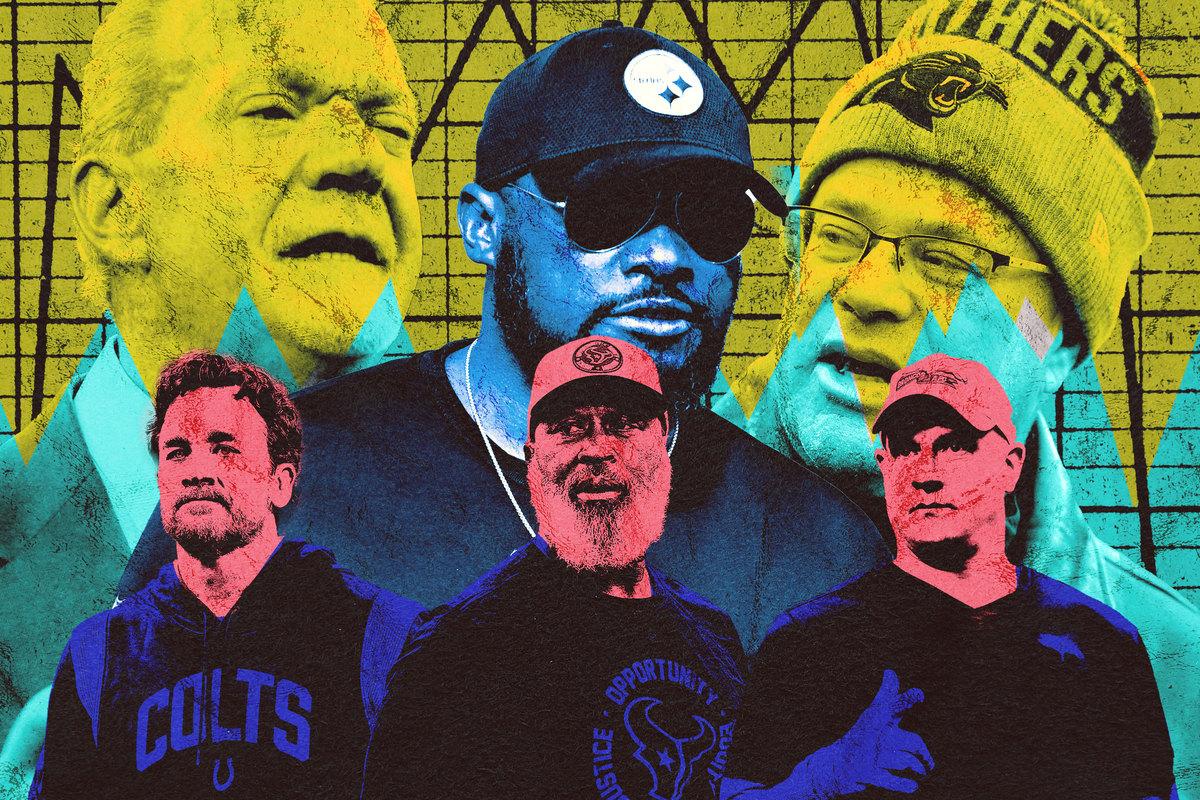
As of publication, we know of five NFL teams—the Indianapolis Colts, Denver Broncos, Carolina Panthers, Houston Texans, and Arizona Cardinals—that are in the market for a new head coach. It’s possible that this number will increase in the days ahead.
Picking a good head coach is hard, and oftentimes NFL owners have no idea where to start. To presume that these organizations operate like well-oiled machines would be a mistake. The truth is that owners are probably looking at the same media-reported lists as everyone else when trying to identify strong candidates.
Luckily, I am here to help. I don’t have all the answers, but maybe I can at least offer some guidance. C’mon—NFL owners’ processes have led to Urban Meyer, Joe Judge, and Matt Patricia in recent years. What do they have to lose?
So, this is my open letter to David Tepper, Jim Irsay, Michael Bidwill, Cal McNair, and especially the Walton-Penner group in Denver, which is going through this process for the first time: Just follow the 10 guidelines below. These don’t ensure success. You’re operating in a world of uncertainty. But at least they’ll give you a shot.
1. Hire a person, not a scheme.
You are looking for a leader, not an X’s and O’s savant. If you get both? Great. But nothing is more important than leadership. The head coach is the person who sets the tone for every department in the building. They need to be authentic and willing to put in the time to build relationships throughout the organization. They need to be able to communicate with everyone—the front office, the owner, their assistants, the players, the training staff, the equipment staff, the media, and so on. They’re the voice of the franchise, the person who needs to keep everyone grounded when things are going well and to take responsibility when things are going badly.
And you can trust that at some point, things will go badly. Just look at some of the best coaches in the NFL. Andy Reid went 12-20 in his final two years with the Eagles. Bill Belichick has failed to make the playoffs in two of the last three seasons. Pete Carroll was fired twice before his stint in Seattle. When a team is struggling and the coach is taking heat, how do they handle it? Are they accountable? Or do they prioritize staying employed by blaming others? Do players and other members of the organization believe that the coach is capable of getting them through adversity? Or will they quickly lose faith?
Leadership can be hard to evaluate, but it’s the most important quality to look for in a head coach. Find someone who is process oriented, and try to avoid volatile personalities. The seasons are long, and there will be ups and downs. Consistency matters. If you don’t hire a great leader, most of the other stuff won’t matter.
2. Find a coach who understands what their job is.
Last offseason, Mike Tomlin appeared on The Pivot Podcast and gave one of the best interviews I’ve ever heard about coaching in the NFL. The standout part was when Tomlin explained how a lot of coaches don’t understand what they’re being paid to do.
“I love to hear coaches resist the responsibility of coaching,” Tomlin said. “They’ll talk negatively about a dude that can’t learn and blah, blah. Man, if everybody could learn, we’d need less coaches. Right? If the group didn’t need management, then we wouldn’t make as much.
“I love reading draft evals and somebody’s talking about anything other than pedigree, talking about how poor somebody’s hand usage is. Well, that’s coaching. I don’t run away from coaching. I run to coaching. It all is in line with not seeking comfort, because when you’re a coach that’s talking about, ‘Somebody can’t learn,’ you’re seeking comfort because your teaching is struggling.”
Think about draft season, when anonymous NFL people rip a quarterback prospect because they didn’t take snaps under center in college. Or slam a wide receiver because they didn’t run a full route tree. Or criticize a cornerback because they didn’t play a lot of man coverage. Oh, you mean college prospects don’t come into the league as finished products? Your job as a coach is to help them improve and hone their skills. As Don Draper would say, that’s what the money’s for!
Unfortunately, not all coaches seem to understand this. They make excuses about personnel and blame execution. One of the first lines of a coach’s job description should be Get the players to execute. Talent matters, but if the players are failing, that often means the coaches are failing. The best coaches can do more with less. They know they’re paid to help players improve and put them in positions to succeed. Coaching is about accentuating strengths and masking weaknesses. Make sure you find a candidate who understands these things.
3. Make sure they can build out a strong staff.
This is a big part of the interview process, and rightfully so. A coach can be terrible at many aspects of their job, but if they nail this one, they can probably still keep things afloat.
Does the candidate plan on hiring their buddies from previous coaching stops? How many staff spots are they allocating to their children? Are they leaning on guys who are represented by the same agent as them?
Or are they searching far and wide for talented, creative, capable people? Are they looking for a blend of new ideas and experience? Do they value diversity? What’s their plan for identifying up-and-coming coaches of color and female coaches?
Not every team is the same, but oftentimes the offensive and defensive coordinators are the ones responsible for creating game plans, play-calling, and making adjustments. Delegating responsibility has to be part of the equation. Head coaches need competent people they can trust, or the micromanaging takes over and the whole operation falls apart.
And it’s not just coordinators. The position coaches matter too—a lot. They are responsible for helping individuals get better, especially backups and players on the practice squad who might be depended on at some point in the season.
If you can find a coach who is a strong communicator and can assemble a great staff, you’re already going to have a leg up on most teams.
4. Find someone who’s willing to give players a voice.
NFL head coaches tend to have huge egos, and some certainly think that they’re the stars. Others realize that they’re only as good as their players. You want the latter. That means creating an environment where players can let their personalities show. It’s one of the things Tomlin does best.
“I desire to create a culture and atmosphere where, first and foremost, people can be themselves,” Tomlin said on The Pivot Podcast last year. “We got a job to do. Football’s our game. Our business is winning. So we all know what the job is. But there’s latitude to be the individuals that you are in the midst of that. And it’s OK.”
There’s a real benefit to building a culture where players enjoy coming to work every day, feel like their voices are being heard, and earnestly believe that the coaches are going to help them get better. It’s not going to be rosy all the time. Players are going to have complaints about their roles or the scheme or playing time or team rules. But the days of the “my way or the highway” coaches are mostly over. The far better approach uses open communication and dialogue.
“Coaches like to think we listen. Coaches don’t listen,” Tomlin said. “They wait for dudes’ mouths to stop moving. … When dudes are talking, I listen. I listen for real. It doesn’t necessarily mean that it’s going to produce action that’s in alignment with what they want, but I listen. I try to keep it real simple.”
5. Prioritize offensive efficiency.
In the past 10 years, 35 of the 40 teams (87.5 percent) that played in the conference championship round had a top-10 offense, according to Football Outsiders’ DVOA metric. Rules in the modern NFL favor the offense. If you don’t acknowledge that offensive efficiency is king, you’re probably going to get left behind.
An important note before you yell at me: This doesn’t mean you have to hire an offensive-minded head coach. Some of the NFL’s best head coaches have a defensive background, but you need a coach who has a vision for the offense and a plan for hiring great offensive coaches.
Take Buffalo’s Sean McDermott, for example. He comes from a strong defensive background, but he realizes he’s been gifted with a transcendent quarterback in Josh Allen. The Bills have been the second-most pass-heavy team in the NFL in the past three seasons. McDermott lost offensive coordinator Brian Daboll to the Giants and replaced him with QB coach Ken Dorsey to ensure continuity for Allen, and the offense has still performed well. McDermott has his preferences for how he wants to play, but he’s willing to adjust to the personnel he has and play whatever style gives the Bills the best chance to win.
Bottom line: If a candidate believes they can consistently win games 17-13 in the modern NFL, you should probably end the interview and go in a different direction.
6. Emphasize the need for flexibility.
Every coach has their core philosophies, and there’s nothing wrong with that. But trends change often, and teams that are able to adjust have an advantage.
Pretty much every coach says they’ll cater their scheme to personnel, but very few are capable of actually doing so. You might interview a candidate who believes strongly in blitzing and playing man coverage. How willing are they to rush four and play zone if that’s what a situation calls for?
Again, coaching in the NFL is hard. You might face Lamar Jackson and the Ravens’ diverse run game one week and Joe Burrow and the Bengals’ downfield passing attack the next. Are you able to come up with opponent-specific game plans and coach your players without overwhelming them? Or are you a “we do what we do” coach? It’s becoming harder and harder to have success with the latter.
Rigidity can be a fatal coaching flaw. Look for someone who has a proven history of being able to adjust.
7. Make sure the coach has a plan for game management.
Nathaniel Hackett seems like a very nice man. But I’m sorry, this has to be known as the “Hackett rule.” None of us can unsee what transpired with the Broncos this season. Hackett was in over his head from a game-management standpoint from Week 1 on, and the way he consistently mismanaged his use of time-outs and mishandled late-game scenarios was just one of many reasons he was fired before the end of his first season in Denver.
Coaches will brag about working 20-hour days and sleeping on mattresses in their offices and never seeing their families. They spend absurd amounts of time grinding film and looking for tendencies that can give their teams an edge. Then the games start, they’re faced with a key fourth-down decision, and they rely on their gut. This makes no sense!
Teams have analytics staffers. There are people available to tell them what the optimal decision is in any situation. For example, a staffer might be able to quickly communicate “green” to go for it on a fourth down or “red” to punt or kick. Other times, it’s “yellow,” which means it’s pretty much 50-50; the coach can do what they think is best.
My preference is for an aggressive coach who uses data. But really, the key is to be open-minded. Think of coaches like John Harbaugh, Doug Pederson, and Nick Sirianni. It’s not like they have extensive math backgrounds, but somewhere along the way, they understood that optimizing in-game decision-making could give their teams an edge.
Other coaches? Not so much. Hackett got a lot of the attention, but his former AFC West counterpart Josh McDaniels frequently cost the Raiders by punting and settling for field goals, even though his defense stank. Dennis Allen might have been the most conservative coach in the NFL. Todd Bowles had a number of game-management gaffes. So many coaches cost their teams opportunities to win games with this stuff.
It’s about being organized and having a plan. If you know you’re going to go for it on a fourth down, you can cater your third-down call accordingly. If you know you want to be aggressive because the strength of the team is the offense, you can explain that to players so they’re not surprised on game day.
At times, we probably overrate things like clock management, time-out usage, and fourth-down decision-making because the mistakes are so obvious when we’re watching games. Other qualities, like leadership and coaching philosophies, might be more important, but game management matters, and the coaches who understand that give their teams an edge.
8. Cast a wide net during the interview process.
In a perfect world, you’re not doing this every two to three years (or every year, if you’re the Texans or Broncos). Take advantage of the opportunity. When else can you bring coaches in from other teams, ask them questions, and gather information? Never.
The candidates are incentivized to bring their best ideas to the table. And guess what: You can steal them! Maybe someone impresses you but isn’t quite ready to be a head coach. There could be an opportunity to hire them for a different role down the line, and now you have a relationship with them.
Think about how silly the current process is. Owners look at what the best teams are. Then they look at who the coordinators on those teams are. And those coaches become the trendiest candidates. What are the odds that those coaches are actually the best candidates in the entire pool? Pretty low! Just because you were a coordinator on a great team doesn’t mean you are going to be a great head coach.
The point is you should cast a wide net—position coaches, college coaches, minorities, women—and not just because the NFL’s Rooney Rule says you have to. Listen to their ideas. Use this as a way to reset your organization and implement necessary changes. Go into the process acknowledging that there’s no perfect way to identify a great candidate, and be open to finding one anywhere.
9. Don’t get duped by the heavyweight endorsement.
This is a trap that owners often fall into. Belichick is the greatest coach of his generation. He endorsed Judge to the Giants. That didn’t work out so well. Peyton Manning is one of the greatest quarterbacks of all time. He endorsed Adam Gase to the Jets. Whoops.
Coaching acumen is not easily passed from one person to another. Just because someone was in charge of getting Kyle Shanahan coffee doesn’t mean that they’re going to call plays like him. More than anything, the big-name endorsement gives owners comfort and helps with their public relations campaign. At the introductory press conference, they can talk about how [insert respected person’s name] raved about the candidate. Remember when the Cardinals hired Kliff Kingsbury? In the press release, they actually mentioned how he’s “friends with Rams coach Sean McVay.”
Is it useful to talk to people who have worked with a candidate in the past? Of course. Gather information. Figure out what’s useful. But you don’t have to hire a candidate just because a coach or player you respect recommends them.
10. Define the coach–general manager power structure.
This needs to be laid out from the beginning. Politics can take over NFL buildings, and power struggles happen all the time. Try to get ahead of the problem. Define roles from day one. The best setup, in my opinion, is to align the coach and GM on the same track. If one of them succeeds, they both succeed. If one of them fails, they both fail. Make sure they know that so they don’t resort to finger-pointing the minute things go south.
Granted, that type of setup will not always be possible. Sometimes, one of the two, either the head coach or the GM, is clearly better at their job than the other. The key is transparency from the get-go. How much input is the coach going to have on personnel matters? Who makes the final call on draft picks and game-day rosters? What is the process going to be like?
It’s important for these two people to be in sync and willing to work through conflict for the organization to achieve sustained success.
If you read the 10 guidelines and thought, “Belichick doesn’t fit into these categories,” you’d be correct. If you’re an owner who has convinced yourself that you’ve found the next Belichick, you’re going to end up being disappointed.
All you can do is try to implement a sound process, avoid the common mistakes laid out above, acknowledge the role of luck and uncertainty, and hope for the best.

